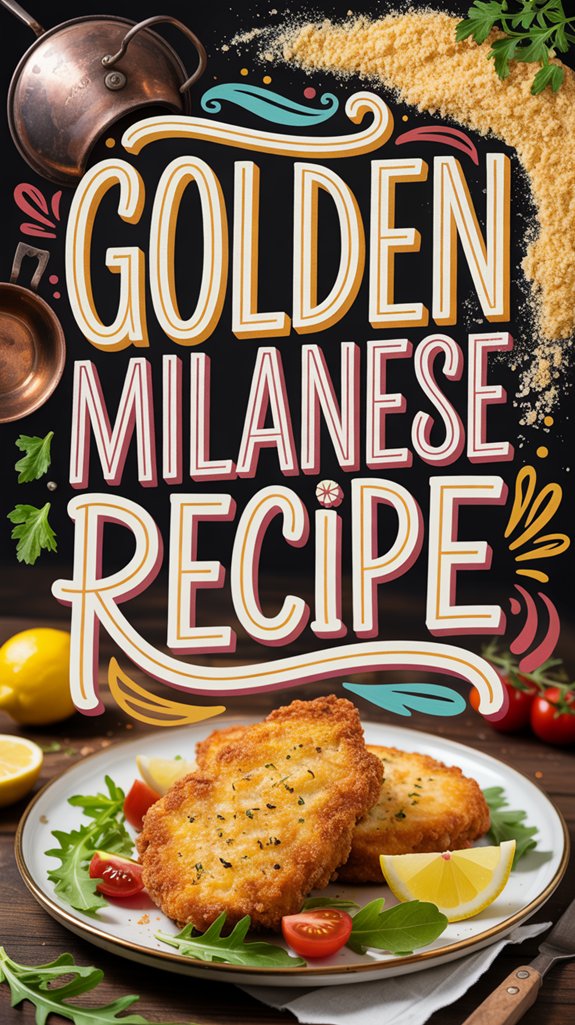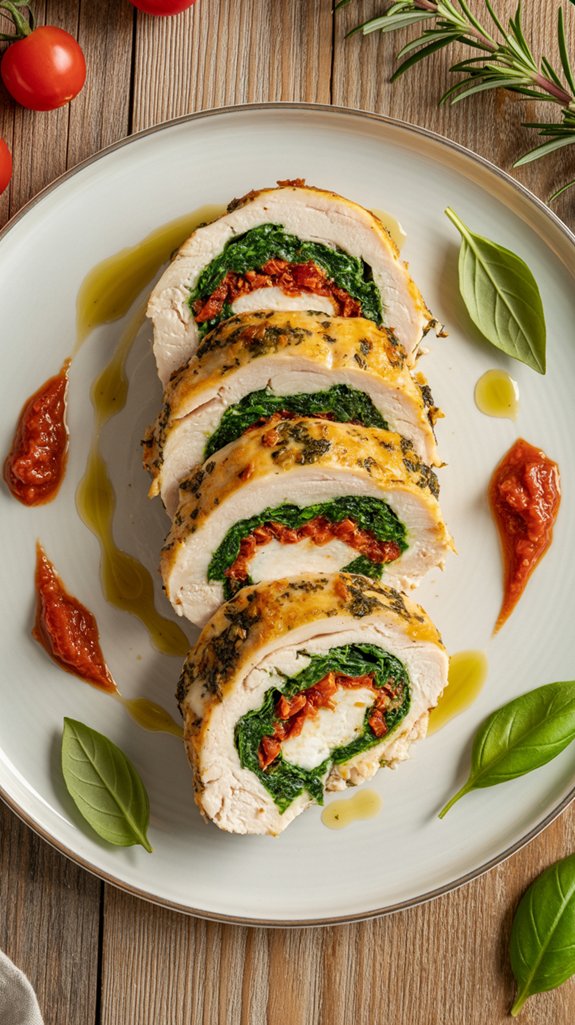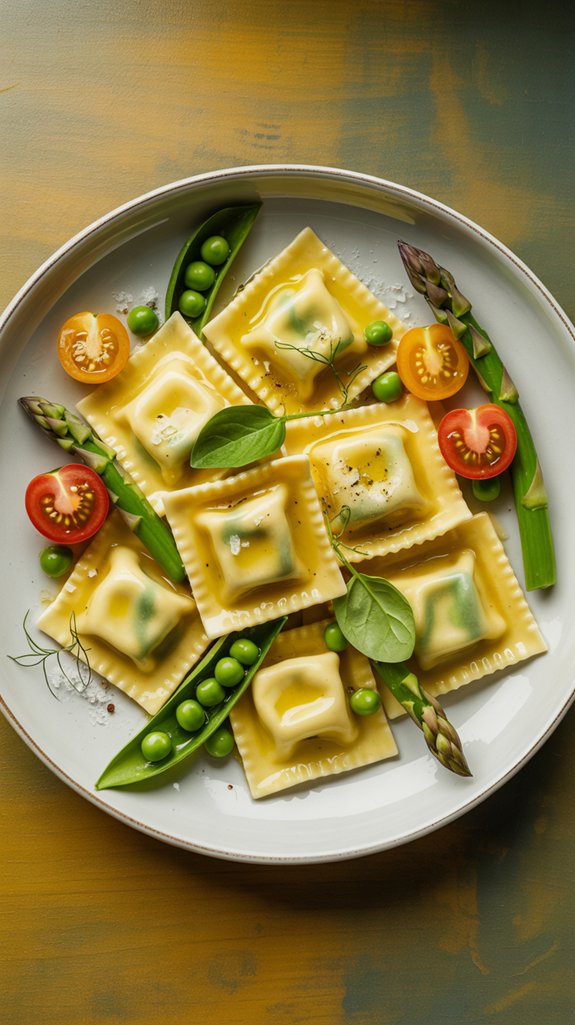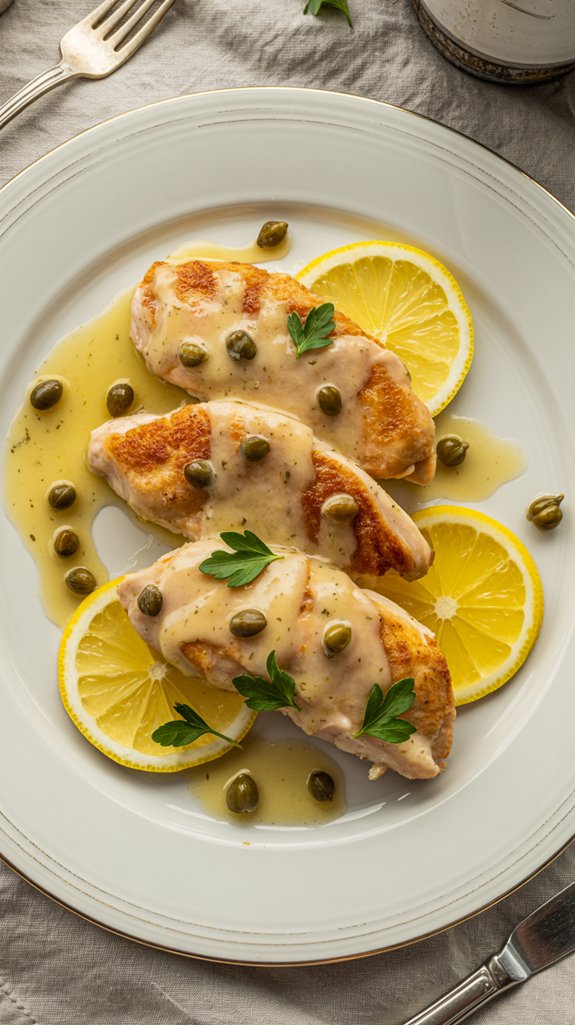Why You’ll Love This this Crispy Italian Chicken Milanese
This crispy chicken milanese brings restaurant-quality Italian comfort food right to your kitchen, with golden-brown chicken that’s tender on the inside and perfectly seasoned on the outside.
The homemade balsamic butter sauce with garlic takes things up a notch, drizzling over that gorgeous chicken like liquid gold while those herb-roasted potato wedges steal the show as the perfect side.
Fresh arugula salad cuts through all that richness, giving you the perfect bite every single time – it’s the kind of meal that makes you feel fancy without breaking a sweat.
Ingredients List
Let me break down everything you need to make this absolutely gorgeous chicken milanese that’ll have your kitchen smelling like an Italian trattoria.
- 4 boneless skinless chicken breasts (cleaned and rinsed)
- 2 cups all-purpose flour
- 2 tablespoons balsamic vinegar
- 2 teaspoons lemon juice
- 4 garlic cloves, sliced
- 4 medium russet potatoes, cut into wedges
- 2 teaspoons Italian seasoning
- Salt and pepper
- 10 ounces arugula or mixed greens
- 1/2-1 cup vegetable oil or peanut oil
- 2 tablespoons butter
- 2 teaspoons lemon pepper
- 4 medium tomatoes, sliced and quartered
- 1/2 cup Italian dressing
- 2 teaspoons extra virgin olive oil
Ingredient Health Considerations:
- Choose organic chicken breasts when possible for better flavor and fewer additives
- Swap regular flour for whole wheat flour to add fiber, though it’ll change the texture slightly
- Use heart-healthy olive oil instead of vegetable oil for pan-frying if you prefer
- Fresh herbs can replace dried Italian seasoning for more antioxidants and brighter flavor
- Consider low-sodium Italian dressing or make your own to control salt content
Step by Step Directions
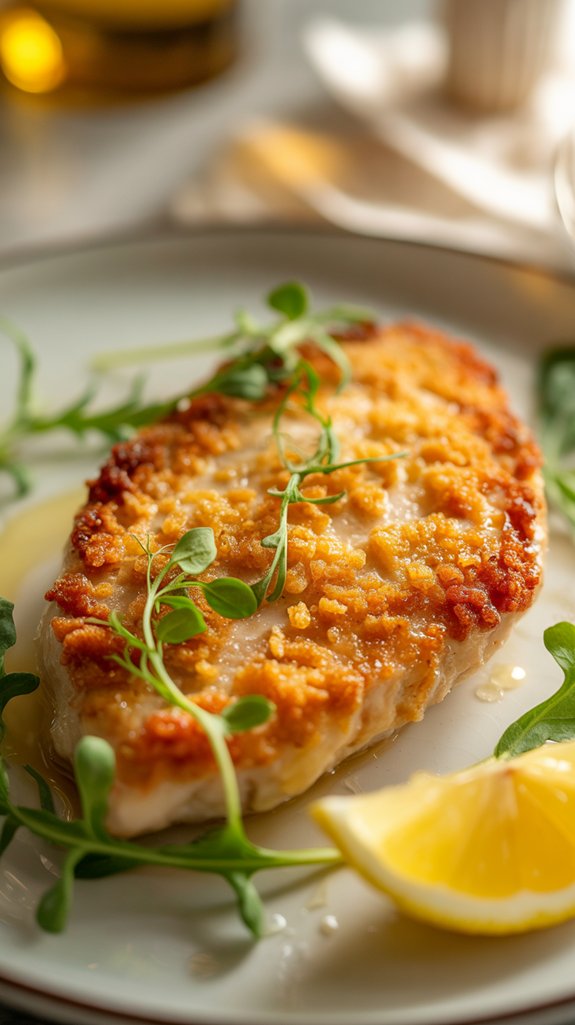
Making this crispy chicken milanese involves preparing the chicken, roasting potatoes, and creating a fresh salad with a savory pan sauce.
• Prepare the Chicken: Place cleaned chicken breasts on a flat surface and butterfly each breast by cutting horizontally 4 inches in, following down to the tail end to create even halves without separating completely.
Pat dry and season both sides with salt, pepper, and lemon pepper. Coat each breast with flour, shaking off excess.
• Cook the Chicken: Preheat skillet to medium heat and add 1/2 to 1 cup cooking oil depending on skillet depth.
Pan sear each chicken breast 3 minutes per side until golden brown and fully cooked through. Drain on paper towels for 2 minutes.
• Roast the Potatoes: Peel potatoes and cut into wedges. Place on parchment-lined sheet pan and drizzle with 2 teaspoons olive oil, Italian seasoning, lemon juice, salt, and pepper.
Roast at 325°F for approximately 20 minutes until fork tender.
• Prepare the Salad: Combine arugula or mixed greens in mixing bowl with quartered tomato slices and Italian dressing.
Add black pepper if desired and gently toss. Divide into 2-ounce portions per plate.
• Make the Pan Sauce: Return chicken skillet to moderate heat using pan drippings.
Stir in butter, balsamic vinegar, and sliced garlic cloves. Cook for 1 minute while stirring.
• Plate and Serve: Place each chicken breast on plate and drizzle with pan sauce.
Add potato wedges alongside chicken and serve with prepared salad.
For best results, use a quality professional chef cookware set that provides even heat distribution and superior cooking performance.
Substitutions and Variations
• Sauce Variations: Skip the balsamic and try white wine with fresh herbs like thyme or rosemary.
Lemon butter sauce is classic, or go wild with a creamy mushroom pan sauce using the same drippings.
• Gluten-Free Route: Almond flour or gluten-free flour blend work fine for coating, though the texture changes slightly.
Rice flour creates an especially light, crispy coating that’s worth trying.
Additional Things to Serve With This Dish
While the arugula salad and roasted potatoes make this dish complete, there are plenty of other sides that pair beautifully with crispy chicken Milanese.
- Classic Italian sides work wonderfully here – think creamy risotto, garlic-butter pasta, or even a simple spaghetti aglio e olio. The richness complements the crispy chicken without competing for attention.
- Light vegetable options keep things fresh and balanced. Roasted asparagus with lemon, sautéed spinach with garlic, or grilled zucchini ribbons all add color and nutrition to your plate.
- Starchy comfort foods never disappoint alongside this dish. Creamy polenta, herb-roasted fingerling potatoes, or even a warm farro salad with cherry tomatoes create a satisfying, restaurant-quality meal.
- Fresh accompaniments brighten the whole atmosphere. A simple caprese salad, marinated olives and fresh mozzarella, or even a classic Caesar salad provide that acidic contrast that makes each bite of chicken taste even better.
- Wine-friendly additions elevate the entire dining atmosphere. Antipasto platters, bruschetta with fresh basil, or a charcuterie board with aged cheeses turn dinner into something special, perfect for when you want to impress without the stress.
Cooking Tips & Tricks (Chef’s Notes)
Getting perfect chicken Milanese isn’t just about following the recipe – it’s about knowing the little secrets that turn good into absolutely amazing.
- Pound it out for even cooking – Before you butterfly those breasts, give them a gentle pound with a meat mallet or rolling pin. This helps everything cook evenly and prevents those dreaded thick spots that stay raw while the edges turn into leather.
- Double-dredge for extra crunch – Dip your floured chicken back into beaten egg, then into seasoned breadcrumbs or more flour. Yes, it’s messy, but that double coating creates the kind of golden crust that makes people ask for your secret.
- Test your oil temperature – Drop a pinch of flour into the oil, and if it sizzles immediately without going crazy, you’re golden. Too hot and you’ll burn the outside before the inside cooks, too cool and you’ll end up with greasy, soggy chicken that nobody wants.
- Don’t crowd the pan – I know you want to get dinner on the table fast, but cramming multiple pieces into one pan drops the oil temperature and creates steam. Cook one or two pieces at a time for that perfect crispy exterior.
- Rest before slicing – Let that beautiful chicken sit for just a couple minutes after cooking. The juices redistribute, and you won’t have a flood of liquid running all over your cutting board when you slice into it.
- Save those pan drippings – Those brown bits stuck to the bottom of your pan are pure flavor gold. Deglaze with wine, broth, or even water to create an instant pan sauce that transforms this from weeknight dinner to restaurant-worthy masterpiece.
Nutritional Facts
This hearty Italian-style meal delivers a balanced combination of protein, complex carbohydrates, and fresh vegetables.
- Calories per serving: Approximately 650-700 calories
- Protein: 45-50g from the chicken breast, supporting muscle maintenance and satiety
- Carbohydrates: 35-40g primarily from roasted potato wedges
- Fat: 25-30g from cooking oil, butter, and olive oil dressing
- Fiber: 4-5g from arugula, tomatoes, and potato skins
- Sodium: Moderate to high depending on seasoning amounts and Italian dressing choice
- Vitamin C: Excellent source from tomatoes and arugula
- Potassium: Good source from potatoes and leafy greens
- Iron: Moderate amount from chicken and dark leafy greens
- Vitamin A: Present in arugula and tomatoes for eye health
- Lean protein ratio: High-quality complete protein makes up about 30% of total calories
- Antioxidants: Abundant in arugula, tomatoes, and garlic for immune support
Fun “Did You Know?”
Although Chicken Milanese originated in Milan, Italy, it’s actually inspired by Austria’s famous Wiener Schnitzel, brought to northern Italy during the Austrian occupation in the 19th century.
I find it fascinating that this beloved Italian dish has Austrian roots! The traditional Milanese version uses veal, but chicken became popular as a more affordable alternative.
What’s really interesting is that authentic Milanese doesn’t include tomato sauce – that’s an American addition. The dish was originally served simply with lemon wedges and arugula.
It’s amazing how recipes evolve as they travel across borders and generations, adapting to local tastes and ingredients.


